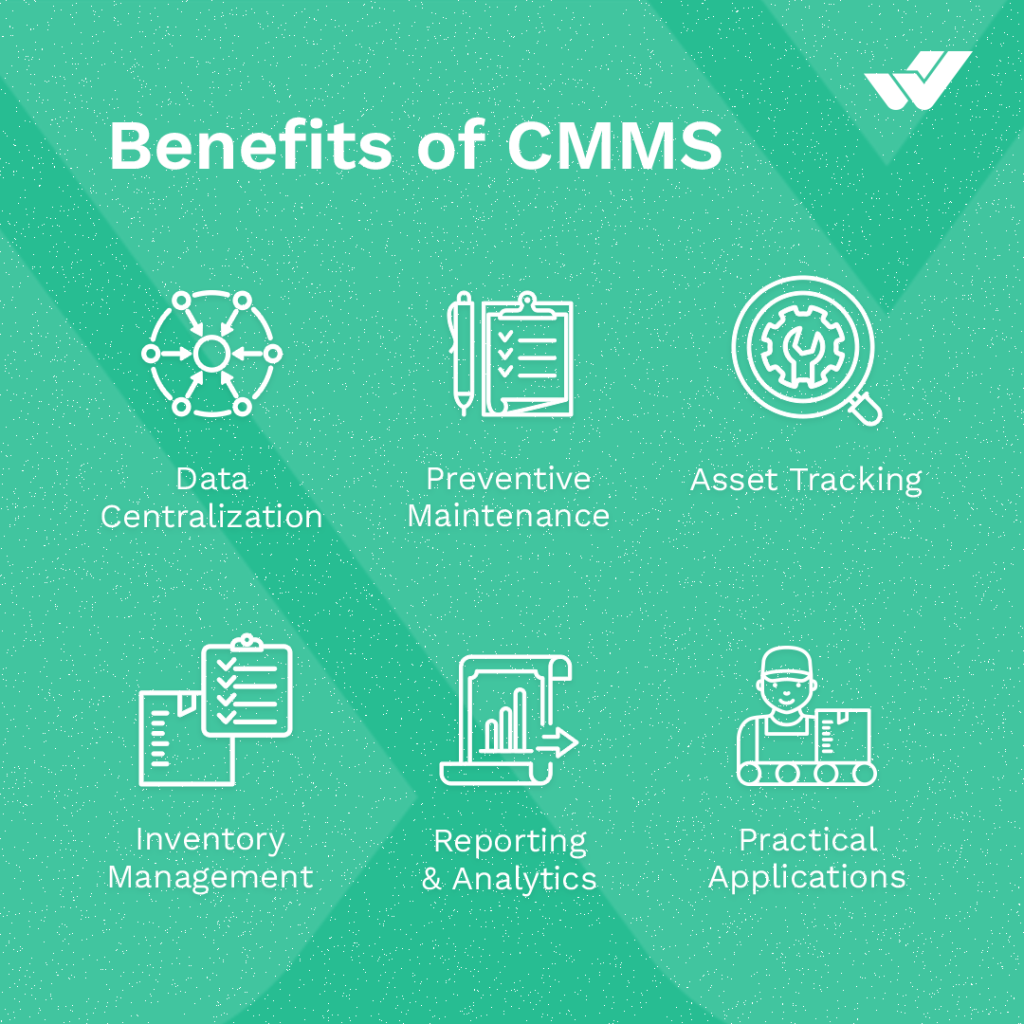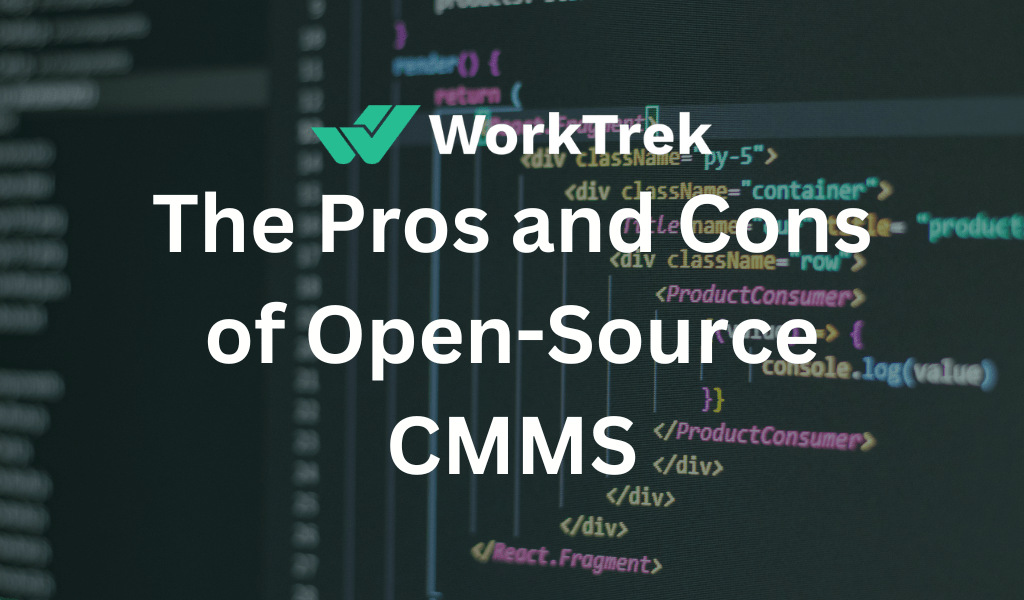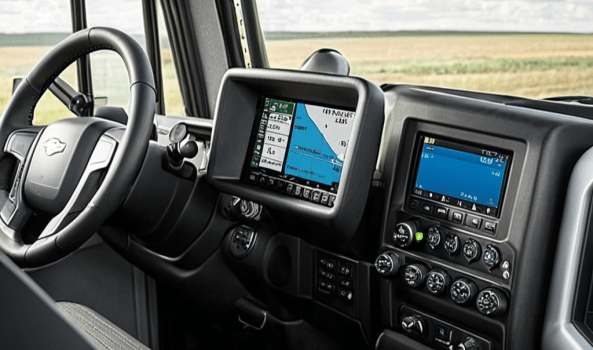Get a Free WorkTrek Demo
Let's show you how WorkTrek can help you optimize your maintenance operation.
Try for freeIntroduction
Companies seeking CMMS software or computerized maintenance management systems may face some important decisions. This type of business resource is extremely valuable and can save a lot of time, effort, and money. One of the most important decisions you should make when choosing a CMMS system is whether to choose a proprietary licensed product or CMMS open-source software.
What is an Open-Source CMMS?
Open-Source CMMS stands for “Open-Source Computerized Maintenance Management System.” It is a software system designed to help organizations manage and maintain their assets, equipment, and facilities efficiently. The term “open-source” indicates that the software’s source code is freely available for anyone to view, modify, and distribute, usually under open-source licenses like the GNU General Public License.

Open-source software differs from proprietary software in many ways. The name comes from the fact that, unlike proprietary software, the source code is open or can be modified by the user. According to opensource.org, to be officially considered open-source, a program must meet the following ten open-source requirements:
- Free distribution
- Source code
- Derivative works
- Integrity of the author’s source code
- No discrimination against individuals or groups
- No discrimination between areas of activity
In principle, open-source CMMS software does not require a company license. This means that the company no longer has to bear the high costs of research and development undertaken by another company. This also means that it is versatile and can be customized by each user to suit their individual needs.
Instead of ordering the software immediately or even through the vendor’s portal, open-source software users can access public software repositories to obtain open-source products. Open-source maintenance management software can be set up by users themselves, often with little or no support.
A simple example of closed source vs. open source is Microsoft Word and OpenOffice – these products are very similar word processors, but one is proprietary and very restricted and the other is open source and free.

Free vs. Open-Source CMMS
Some open-source maintenance software is free, but not all: free and open-source are not the same thing, although they are used interchangeably in some areas. Open-source software also comes with many different types of licenses, which determine the price, use, and redistribution of the program.
Even software labeled “free” doesn’t necessarily mean free – it can also refer to freedom of use and customization.
Here’s a comparison of open-source CMMS and free CMMS, highlighting the key differences:
Open-Source CMMS:
- Source Code Access: Open-source CMMS provides access to the source code, allowing users to view, modify, and redistribute it. This offers a high degree of customization.
- License Flexibility: CMMS software typically comes with open-source licenses, such as the GNU General Public License (GPL), which may have certain conditions for modification and redistribution.
- Community Support: These systems often have active communities of developers and users who contribute to ongoing development, provide support, and share insights.
- Cost: Open CMMS may or may not come with a price tag. It can be free or involve associated costs for customization, support, or additional features.
- Customization: Users can customize open-source CMMS to align with their specific maintenance needs and integrate it with other systems.
- Vendor Independence: Organizations are not locked into a single vendor, giving them more control and flexibility over the software’s usage, updates, and support.
- Transparency: The source code’s transparency allows users to verify security, inspect the code, and adapt the software to their requirements.

Free CMMS:
- No Cost: Free CMMS software is entirely cost-free, with no associated licensing fees, customization costs, or ongoing fees for basic features.
- Limited Customization: CMMS software usually has limited or no customization options and users cannot access or modify the source code.
- Limited Support: Free CMMS solutions might offer limited or no official technical support or community support, potentially leaving users to rely on their own resources.
- Feature Set: CMMS solutions may offer a basic set of features for maintenance management but might lack some advanced capabilities found in paid solutions.
Similarities:
- Both free software and open-source software provide access to the source code, allowing users to modify and improve the software.
- Both types of software often rely on a community of users and developers to provide support and contribute to the development of the software.
- Free software and open-source software are typically distributed under open licenses, which allow users to use, modify, and distribute the software without restrictions.
In summary, the primary difference is that open-source CMMS provides access to the source code, offering extensive customization and flexibility, while free CMMS software is cost-free but typically comes with limitations in terms of customization and support.

The Pros of Open-Source CMMS
Open-source CMMS (Computerized Maintenance Management System) offers several advantages, making it an attractive choice for organizations looking to manage maintenance and assets efficiently. Here are the key advantages:
- Cost-Effective: Open-source CMMS is typically free to use or available at a lower cost compared to proprietary CMMS solutions, reducing overall expenses.
- Customization: Users can modify the software to meet their specific maintenance needs. This flexibility allows organizations to adapt the system to their unique processes and requirements.
- Community Collaboration: The open-source community can contribute to the development and improvement of the software. This collective effort often results in rapid bug fixes and feature enhancements.
- Community Support: Many open-source projects have active communities that provide support, documentation, and forums where users can seek help and share best practices.
- License Flexibility: Organizations have the freedom to choose from various open-source licenses to align with their specific legal and usage requirements.
· Comprehensive Features: Many open-source CMMS solutions offer a wide range of features for asset management, work order tracking, preventive maintenance, and reporting.
Best CMMS platforms can be valuable tools for organizations of all sizes and industries, allowing them to efficiently manage maintenance activities, track assets, and ensure the smooth operation of equipment and facilities.

Supercharge your maintenance with WorkTrek CMMS!
Book a WorkTrek demo to see how a CMMS can help your business.
Try for freeThe Cons of Open-Source CMMS
While open-source CMMS (Computerized Maintenance Management System) offers many advantages, it’s important to be aware of the potential disadvantages and challenges associated with using open-source software in this context. Here are some of the cons of open-source CMMS:
- Lack of Official Support: Open-source CMMS solutions may not come with the same level of official technical support as proprietary alternatives. While there may be community support, it might not be as comprehensive or responsive.
- Customization and Maintenance: While customization is an advantage, it can also be a disadvantage. Organizations may need in-house technical expertise or external developers to adapt the software to their specific needs and maintain these customizations over time.
- Limited Vendor Accountability: In the event of issues or disputes, there may be a lack of accountability as open-source projects are often maintained by volunteer contributors or organizations that may not be legally responsible for the software’s performance.
- Hidden Costs: While open-source CMMS software itself may be free, organizations may incur costs for customization, support, maintenance, and ongoing development, which can add up over time.
- User Interface (UI) and User Experience (UX): Some open-source CMMS solutions may not offer the same level of user-friendly interfaces or features as proprietary options, which can affect user adoption and satisfaction.
Before choosing an open-source CMMS, organizations should carefully assess their specific needs, available technical resources, and the level of community support and development activity surrounding the chosen software.

Conclusion
An open-source CMMS (Computerized Maintenance Management System) is maintenance management software with freely accessible source code, allowing users to view, modify, and distribute it. It offers high customization, community support, and flexibility, but may require technical expertise for setup and maintenance.
As with any type of CMMS, open-source systems have many advantages and disadvantages. The main advantages are price, versatility, and customization. Disadvantages include a lack of support, a less user-friendly interface, and the need for self-employment to meet IT needs.









